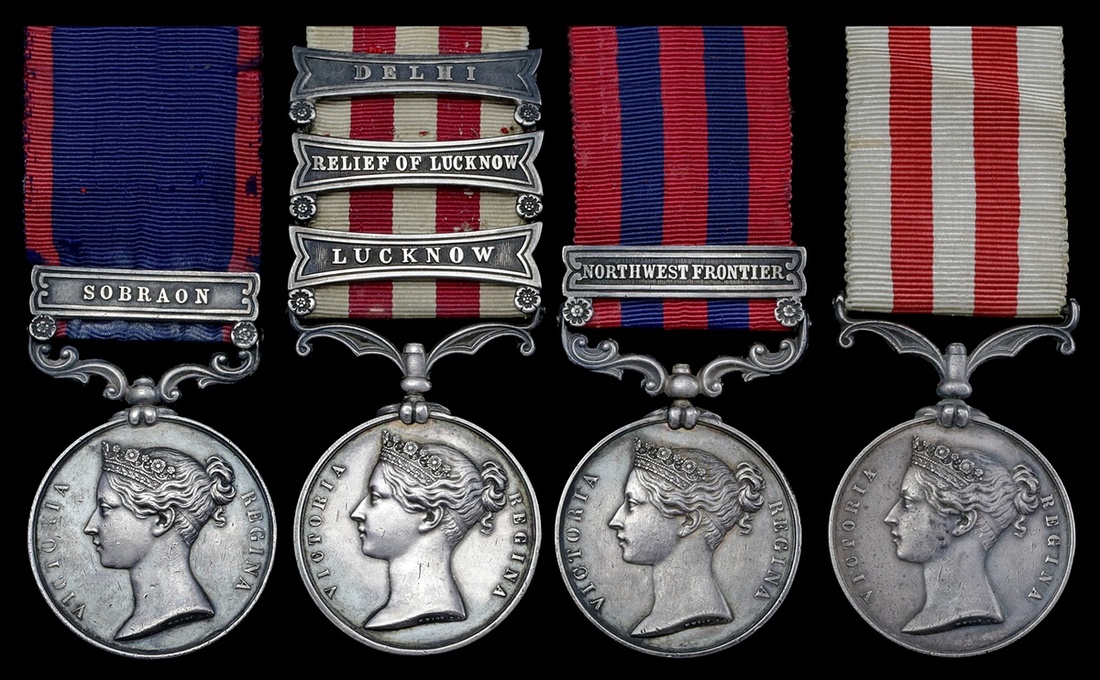
Auction: 19003 - Orders, Decorations and Medals
Lot: 158
(x) A scarce India service group of three to Trumpeter J. Modget, Bengal Horse Artillery, who took part in the battles of Aliwal and Sobraon before joining Sir Colin Campbell's expedition against the Utman Khels. He went on to fight in Brigadier Nicholson's daring counter-attack against the mutineers at Nujjufghur, during the Siege of Delhi. This action saved the British position at a critical moment, raising British morale after two bleak months of stalemate
Sutlej 1845-46, for Aliwal 1846, 1 clasp, Sobraon (H: P: Trumpr J: Moget 2nd Brigade H:Ay.), note surname spelling; Indian Mutiny 1857-59, 3 clasps, Delhi, Relief of Lucknow, Lucknow (Serjt. J. Modget, Bengal H. Art. 1st Bde.); India General Service 1854-95, 1 clasp, North West Frontier (Trumptr. J Modget. 1st Tp. 1. Bde. Bengl. Arty.), light contact marks, nearly very fine
The group is accompanied by a second issue Indian Mutiny Medal, with no clasp, to 'Jas. Mudget 3rd Bengal Eurpn. Regt.', possibly a relative, nearly very fine (4)
J. Modget fought at the Battle of Aliwal (Medal) on 28 January 1846, as a Trumpeter in the 2nd Brigade, Bengal Horse Artillery. The Sikhs occupied an entrenched position with their backs to the River Sutlej. Their right flank was held by a large bastion defended by scarlet-coated Avitable Battalions, crack formations trained by the Italian mercenary Paolo Avitable. The British commander, Sir Harry Smith, quickly identified this bastion as the key to the battle. The 1st and 3rd Troops, 2nd Brigade, Bengal Horse Artillery rode with the 16th Lancers during their famous charge. While the infantry attacked the Sikh front, the 16th Lancers flushed the defenders out of the bastion and into the guns of the Bengal Horse Artillery. Sir Harry Smith later wrote to Brevet Lieutenant-Colonel Alexander, commanding the 3rd Troop, 2nd Brigade:
'I see at this moment yours and Turton's Troops (1st Troop) unlimbering near the nulla when I again unkenelled a pack of Avitabiles to the murderous fire of your glorious guns... Our guns and gunners, officers and men, may be equalled, but cannot be excelled by any Artillery in the world.'
The whole Sikh line collapsed and was driven in confusion across the river, losing all its guns and suffering heavy casualties. For performing this feat the 2nd Brigade, Bengal Horse Artillery sustained 2 men killed and 11 wounded. During the subsequent Battle of Sobraon (clasp) on 10 February 1846, they manned a battery of heavy 18-pounder guns, part of an immense siege train. The Sikh entrenchments stood no chance against such a weight of metal. An officer of the 33rd Native Infantry wrote:
'In the evening I visited the interior of the entrenchments and found that on the front of the heavy guns and rocket battery the destruction had been very great. Numerous tumbrils had been blown up, and several places, occupied by the enemy in dense masses, presented an appearance of charred bodies heaped upon one another.'
Sikh losses at Sobraon were estimated at over 8,000 men and 67 guns. The Bengal Horse Artillery, truly a corps d'elite, lost only 5 killed and 24 wounded (Hughes 1971, 112). This astounding victory led to the Sikh Empire's surrender under the terms of the Treaty of Lahore, which restricted the Sikh army to 25 battalions and 12,000 horse. The Jullundur Doab was ceded to Company rule, and the Sikhs had to promise never again to employ European mercenaries. The victorious British also demanded payment of half a million pounds in reparations, failing which Kashmir would also be ceded. The resentment caused by these terms led to renewed conflict two years later.
Modget served on the North-West Frontier in Brigadier Sir Colin Campbell's 1852 expedition against the Utman Khels (Medal and clasp). On 20 April that year, the British-held village of Charsada was attacked by 200 Utman Khel tribesmen, who killed native government officials and looted the Treasury. Campbell's retaliation was swift, and he laid siege to the town of Pranghar on 13 May. The 1st Troop, 1st Brigade, Bengal Horse Artillery bombarded Pranghar's walls and quickly broke the enemy's resolve.
Modget went on to serve during the 1857 Indian Mutiny at the Siege of Delhi, the Second Relief of Lucknow and the subsequent re-capture of Lucknow by Sir Colin Campbell, earning a rare three clasps to his Indian Mutiny Medal. The 1st Brigade, Bengal Horse Artillery formed part of Brigadier John Nicholson's force at the Battle of Nujjufghur on 25 August. In this desperate action of the Siege of Delhi, Nicholson routed a rebel sortie led by Bakht Khan which threatened to outflank the British force on the ridge. He killed over 800 rebels and captured 13 guns.
Sold with a copy of B. P. Hughes' The Bengal Horse Artillery 1800-1861 (London, 1971).
Subject to 5% tax on Hammer Price in addition to 20% VAT on Buyer’s Premium. For more information please view Terms and Conditions for Buyers.
Sold for
£2,200
Starting price
£1200




